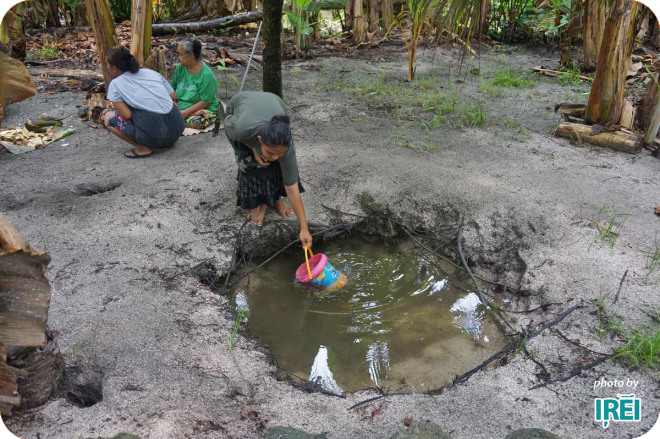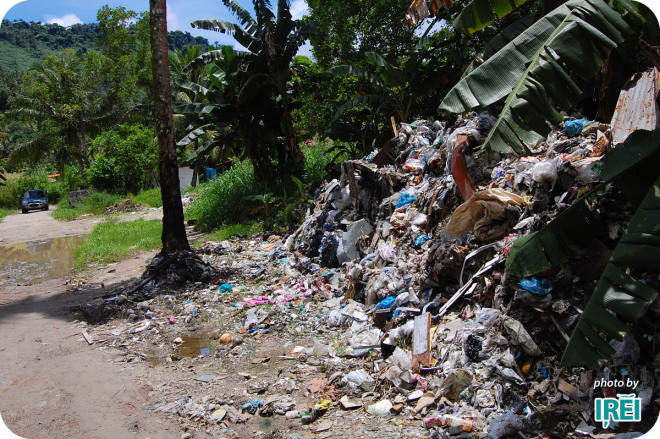Berna
Dr.Muru
Check out the Resources page for these two latest new additions from Danko!
Good group turn out on a Saturday morning in Gargey to install the ‘first’ First Flush Diverter in Yap. Along with the WFL Core Team members, we had community members come to assist and also three Yap State Public Service Corporation staff (from their water division) donate their time and tools to assist. When we opened the old pipe on the catchment, we found rat fecal pellets…breeding place for leptospirosis! The community members cleaned out the pipes and we completed the installation. EPA will be monitoring the catchment water.
On Saturday 9/14, the Yap WFL Team successfully installed the first of five first flush diverters at the typhoon shelter in Gargey village. In addition the the WFL Team members, community members and three staff from the Yap State Public Service Corporation spent their Saturday morning preparing the installation site and installing the diverter. Following the installation, on Monday 9/16, the WFL training team conducted a ‘Safe Drinking Water’ workshop for Gargey community members. Plans are now underway for the remaining diverters. Go Team Yap! Pix to come soon.088
You can find the whole schedule of 177 presentations for the Global 2013 STEMx education conference – listed in terms of your local time zone! – at http://stemxcon.com/page/attending-schedule
A recording of the Blackboard Collaborate session about Water for Life that was presented there can be found at: https://sas.elluminate.com/site/external/jwsdetect/nativeplayback.jnlp?sid=2008350&psid=2013-09-20.1303.D.69D2D8A54FD5F1A28A4B466D9041A4.vcr

The groundwater table tends to be very shallow on the low islands. People dig wells by hand and easily reach fresh water. This is especially true in the interiors of islands with taro patches, where the land surface is lower than around the island perimeter and groundwater is found practically at the land surface. On this photo we see a young Chuukese woman on the island of Piis-Panew, the only permanently inhabited low island in Chuuk Lagoon, grabbing water from a very shallow well. The women in the background are cleaning taro.

This is a photo of a simple exercise designed to demonstrate unique properties of water. The attendees of the first Water for Life workshop in Chuuk enjoyed it. I now invite them to comment on the picture here and explain to other visitors of this blog why the balloon does not pop even though it is touching the fire from the lighter. Let’s practice explaining so we can later try sharing this with students in classrooms.
Originally posted on legdesop:
The Yap WFL Team is awaiting the delivery of the first flush diverters for the first two catchment sites for the Gargey Community. The plans are to install these first two diverters on the typhoon shelter water catchment. Gargey is ‘village’ to many Neighboring Island families. Some of these families are permanent residents and others are temporary families who come to the main island for medical, educational, other reasons, who return to their home islands after a brief stay. WFL Team members met with Gargey council representatives. The plan is to install the first two diverters, conduct a training on water quality for selected residents of the community, and train them on how to monitor water quality of the catchment tanks.We anticipate the first two diverters to be installed and training completed by the end of September 2013.

The image above shows uncontrolled and “out of control” dumping of solid waste, right by the roadside in a downtown area of one FSM island. This is unlawful for many reasons and poses great risks to the health of humans and the environment. In this blog, I just want readers to consider what happens here when water passes through this waste. Rain that falls on the waste pile percolates through it and leaches soluble chemicals from the waste and transports them to nearshore waters — either across the land surface or through soil and groundwater. Injection of such compounds into the coastal zone upsets the nutrient balance there, can cause algal blooms, and can directly kill marine life through toxic or other effects. Human beings suffer too — the pollutants make it to us either from groundwater (which we extract for our potable water supply) or through seafood caught along the shore. Micronesian islands are so far from polluting industries of other countries that we should have the best quality environment, water, and food. No one in Micronesia should tolerate this type of environmental and health threat.
